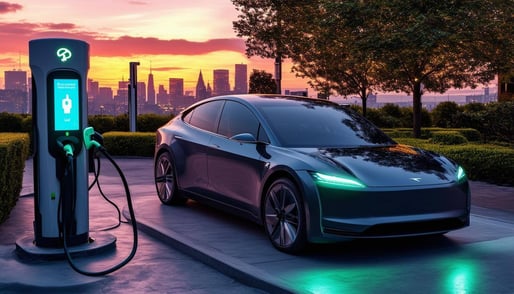Key Points
- U.S. Tariffs Overview: Recent U.S. tariffs on imported EV charging components and materials aim to bolster domestic production but are affecting the North American supply chain.
- Canadian Implications: Increased costs for Canadian manufacturers and consumers, potentially leading to higher prices for EV charging stations and slower infrastructure expansion.
- Supply Chain Adjustments: Companies may shift to alternative suppliers and boost domestic production to mitigate tariff impacts.
- Market Impact: Rising costs may slow EV adoption in Canada, though long-term adaptations and government support could offset short-term challenges.
- Consumer Tips: EV owners are encouraged to stay informed, explore available incentives, and use tools like PlugShare and ChargeHub for planning their charging needs.
Charging Equipment Costs
Canada’s electric vehicle (EV) market is booming, fueled by a strong commitment to clean energy and sustainable transportation. However, recent U.S. tariffs on imported components for EV charging equipment and materials are creating significant challenges that ripple across North America. In this article, we explore the Canadian perspective on U.S. tariffs, discussing their impact on pricing, supply chains, and EV adoption.
Understanding the New U.S. Tariffs
The U.S. government recently imposed tariffs on key imported components—such as semiconductors, specialized metals, and other critical materials—used in EV charging equipment. The objective is to protect domestic manufacturing by increasing the cost of overseas imports. While the move supports U.S. industries, Canadian manufacturers and consumers are now feeling the effects.
For further details on the tariffs, refer to the Office of the United States Trade Representative (USTR).
Implications for Canadian Manufacturers and Consumers
Increased Production Costs
Canadian companies operating in the EV charging sector often rely on a global supply chain. With the new U.S. tariffs, the costs of imported materials are rising, leading to several challenges:
- Higher Equipment Prices: Manufacturers pass increased costs along the supply chain, resulting in more expensive EV charging stations and related infrastructure.
- Delayed Infrastructure Expansion: Elevated production expenses may slow down the deployment of new charging stations, particularly in budget-constrained or underserved regions.
Supply Chain Adjustments
To mitigate the impact of these tariffs, Canadian manufacturers are re-evaluating their sourcing strategies. Some key adjustments include:
- Shifting to Alternative Suppliers: Exploring new partnerships or sourcing domestically can help reduce reliance on tariff-affected materials.
- Investing in Domestic Production: Increased local manufacturing could stabilize prices over the long term, though initial transitions may involve short-term disruptions.
For broader insights on global supply chain adjustments, visit the U.S. Department of Commerce.
Impact on the Canadian EV Market
Effect on EV Adoption
EVs are popular in Canada because of their lower operating costs and environmental benefits. However, if the price of charging equipment rises significantly:
- Consumers May Face Higher Installation Costs: Increased costs can impact both home and public charging station installations.
- Slower Charging Network Expansion: A delayed rollout of new stations might affect consumer confidence and slow EV adoption.
Industry and Government Response
Canadian experts believe that while short-term challenges are expected, the market will eventually adapt. Key strategies to address these challenges include:
- Boosting Local Production: Encouraging domestic manufacturing could lessen Canada’s dependence on imports.
- Accelerating R&D: Investment in research to develop cost-effective materials and production methods can help offset tariff impacts.
- Government Support: Agencies such as Innovation, Science and Economic Development Canada may offer policies and incentives to support the industry during this transition.
Internal Link Suggestion: For more on government initiatives related to EV infrastructure, see our detailed post on Canada’s EV Incentive Programs.
What Canadian EV Owners Can Expect
Canadian EV owners might see the immediate impact of these tariffs in the form of increased installation costs and slower expansion of charging networks. Here are a few practical tips to stay ahead:
- Stay Informed: Follow policy updates and market trends that may affect pricing.
- Explore Available Incentives: Check for federal and provincial programs designed to reduce installation and equipment costs.
- Plan Your Charging Needs: Use tools like PlugShare and ChargeHub to locate nearby charging stations and ensure smooth travel planning.
Looking Ahead
The recent U.S. tariffs on EV charging equipment and materials mark a pivotal moment for the North American EV market. Although Canadian manufacturers and consumers face short-term challenges, these obstacles also pave the way for innovation and greater self-reliance in Canada’s EV sector. With proactive government policies, strategic industry adjustments, and continued investment in technology, Canada is well-positioned to maintain its leadership in clean transportation.
For additional insights into the broader EV market and related policy changes, visit Natural Resources Canada’s Energy Sources and Electric Vehicles page.
Get Involved!
We’d love to hear your thoughts on how U.S. tariffs might affect the future of EV charging in Canada. Leave a comment below, share this article, and follow us on social media for the latest updates on EV technology and market trends.
Thanks for reading!
Don’t forget to check out our other posts on EV infrastructure and sustainability for more expert insights.
Jan 31, 2025 7:43:33 PM



%20and%20a%20Gasoline%20Car.%20The%20background%20.webp?width=520&height=294&name=DALL%C2%B7E%202024-12-09%2016.08.44%20-%20A%20clean%20and%20minimalistic%20infographic%20design%20comparing%20the%20cost%20per%20litre%20of%20traveling%20for%20an%20Electric%20Vehicle%20(EV)%20and%20a%20Gasoline%20Car.%20The%20background%20.webp)
Comments